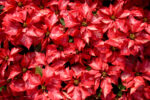Plant Information

Native to Central America, poinsettia (Euphorbia pulcherrima) has become one of the most beloved holiday plants in the United States. With dramatic red bracts and crisp dark green leaves, poinsettia cheers us as the days grow ever shorter. This plant has come to represent festive, joyful times as we celebrate our ties to family and friends. Would December still feel as merry without poinsettias prominently displayed in our homes and businesses? Americans can choose from among dozens of varieties to raise our holiday spirits. And we do … our holiday poinsettia purchases total close to a quarter of a billion dollars annually.
A brief history
Euphorbia pulcherrima, originating in the Taxco del Alarcon region of Southern Mexico, was used by the Aztecs as a source of a purplish dye for textiles and cosmetics and as the base for a medicine to treat fever. This plant may have remained in obscurity if it had not been noticed by Joel Roberts Poinsett (1779 – 1851), the first United States Ambassador to Mexico (1825 – 1829). During a visit to Taxco del Alarcon in 1828, Poinsett became intrigued by the bright red bracts brilliantly displayed during the short days of winter. Although Poinsett had attended medical school to follow in his father’s footsteps, he developed a deep interest in botany. His passion led him to eventually found the institution we now call the Smithsonian Institute. It also led him collect E. pulcherrima during 1828 and take this unique plant home to his plantation in Greenville, South Carolina. Poinsett propagated cuttings from his collection to share with friends and botanical gardens. This plant has subsequently been dubbed the “poinsettia” in the United States and most of the English-speaking world to honor Joel Robert Poinsett.
Breeding and production
During the last 180 years, horticulturalists and breeders have developed new varieties with special characteristics. Beyond the traditional red, available bract color now includes white, cream and pink solids along with various speckles and patterns. Bract shape has also developed over time from a simple leaf shape to twists and ruffling. One of the most desirable traits discovered early last century – enhanced branching after pinching – is now known to be caused by a phytoplasma.
Even with all the breeding programs to develop new colors and forms, production practices are still rooted where poinsettias originated. Poinsettia plants require special production methods to encourage the bracts to change color in time for holiday cheer. Growers must provide shorter days by drawing black cloth over the plants to simulate a longer period of darkness. Even a small flash of light during the night can inhibit the transformation.
Economics
According to the USDA NASS Census of Horticulture, poinsettias sold for a value of $249 million in 2014 and $225 million in 2019.
Main Diseases Problems
Poinsettias have multiple bacterial and fungal diseases: bacterial canker, bacterial stem rot, botrytis flower blight and stem canker, powdery mildew, Phytophthora root and stem rot, Pythium root rot, Rhizoctonia root rot, leaf scab, and Thielaviopsis root rot.
Main Pest Problems
There are multiple insects and mites causing damage on poinsettia including: fungus gnats, whiteflies, western flower thrips, broad mites, Lewis mites, aphids, mealybugs and scales.
IR-4 Research
Of the various diseases and pests affecting poinsettia during production, IR-4 has worked to develop efficacy information on some key problems: Phytophthora root rots, Pythium root rots, bacterial diseases, Botrytis, Q and B biotype whiteflies, mealybugs, scale, and western flower thrips. In addition, IR-4 has conducted 40 crop safety trials to determine whether products may be applied to poinsettias without injury or without leaving unsightly residues.
With IR-4 data the following products have been registered:
- Bacterial diseases*: Regalia, ZeroTol
- Botrytis*: Botector, Broadform, Mural, Orkestra, Regime, Spirato, Stargus
- Phytophthora & Pythium*: Heritage, Insignia, Rootshield Plus, Segway, Subdue Maxx
- Mealybugs and Scale: Aria, Altus, GrandEvo, Sarisa, Ventigra
- Thrips: Altus, Aria, Grandevo, Hachi-Hachi, Mainspring, Overture, Pedastal, Safari, Xxpire
- Whiteflies*: Aria, Grandevo, Pedestal, Rycar, Xxpire
* Supporting data generated on poinsettias.
With these IR-4 research efforts, United States growers will continue to have healthy crops, so we all can continue to brighten our holidays with cheerful, live poinsettia displays.
Authors
Cristi Palmer, IR-4 Environmental Horticulture Program Manager
References
http://www.pauleckepoinsettias.com/html/hist_fset.html
https://mrec.ifas.ufl.edu/LSO/bemisia/bemisia.htm
https://extension.psu.edu/poinsettia-diseases
https://ag.umass.edu/greenhouse-floriculture/fact-sheets/diseases-of-poinsettias
https://www.greenhousemag.com/article/six-poinsettia-pests-and-how-to-overcome-them/
https://aggie-horticulture.tamu.edu/ornamental/the-texas-poinsettia-producers-guide/insect-mite-management/
https://quickstats.nass.usda.gov/
